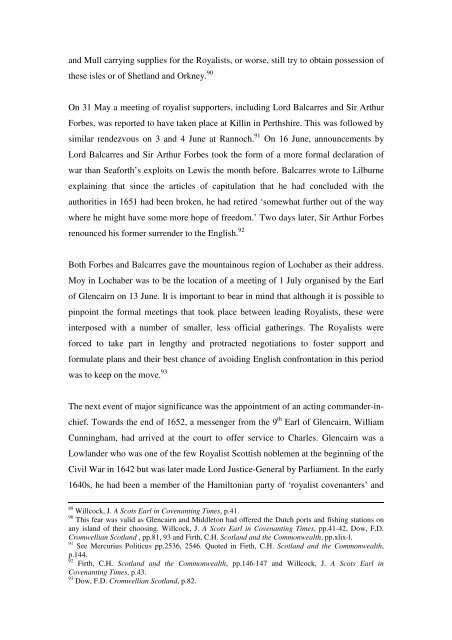The Glencairn Uprising, 1653-54 Helen Baker Department of ...
The Glencairn Uprising, 1653-54 Helen Baker Department of ...
The Glencairn Uprising, 1653-54 Helen Baker Department of ...
You also want an ePaper? Increase the reach of your titles
YUMPU automatically turns print PDFs into web optimized ePapers that Google loves.
and Mull carrying supplies for the Royalists, or worse, still try to obtain possession <strong>of</strong><br />
these isles or <strong>of</strong> Shetland and Orkney. 90<br />
On 31 May a meeting <strong>of</strong> royalist supporters, including Lord Balcarres and Sir Arthur<br />
Forbes, was reported to have taken place at Killin in Perthshire. This was followed by<br />
similar rendezvous on 3 and 4 June at Rannoch. 91 On 16 June, announcements by<br />
Lord Balcarres and Sir Arthur Forbes took the form <strong>of</strong> a more formal declaration <strong>of</strong><br />
war than Seaforth’s exploits on Lewis the month before. Balcarres wrote to Lilburne<br />
explaining that since the articles <strong>of</strong> capitulation that he had concluded with the<br />
authorities in 1651 had been broken, he had retired ‘somewhat further out <strong>of</strong> the way<br />
where he might have some more hope <strong>of</strong> freedom.’ Two days later, Sir Arthur Forbes<br />
renounced his former surrender to the English. 92<br />
Both Forbes and Balcarres gave the mountainous region <strong>of</strong> Lochaber as their address.<br />
Moy in Lochaber was to be the location <strong>of</strong> a meeting <strong>of</strong> 1 July organised by the Earl<br />
<strong>of</strong> <strong>Glencairn</strong> on 13 June. It is important to bear in mind that although it is possible to<br />
pinpoint the formal meetings that took place between leading Royalists, these were<br />
interposed with a number <strong>of</strong> smaller, less <strong>of</strong>ficial gatherings. <strong>The</strong> Royalists were<br />
forced to take part in lengthy and protracted negotiations to foster support and<br />
formulate plans and their best chance <strong>of</strong> avoiding English confrontation in this period<br />
was to keep on the move. 93<br />
<strong>The</strong> next event <strong>of</strong> major significance was the appointment <strong>of</strong> an acting commander-inchief.<br />
Towards the end <strong>of</strong> 1652, a messenger from the 9 th Earl <strong>of</strong> <strong>Glencairn</strong>, William<br />
Cunningham, had arrived at the court to <strong>of</strong>fer service to Charles. <strong>Glencairn</strong> was a<br />
Lowlander who was one <strong>of</strong> the few Royalist Scottish noblemen at the beginning <strong>of</strong> the<br />
Civil War in 1642 but was later made Lord Justice-General by Parliament. In the early<br />
1640s, he had been a member <strong>of</strong> the Hamiltonian party <strong>of</strong> ‘royalist covenanters’ and<br />
89 Willcock, J. A Scots Earl in Covenanting Times, p.41.<br />
90 This fear was valid as <strong>Glencairn</strong> and Middleton had <strong>of</strong>fered the Dutch ports and fishing stations on<br />
any island <strong>of</strong> their choosing. Willcock, J. A Scots Earl in Covenanting Times, pp.41-42, Dow, F.D.<br />
Cromwellian Scotland , pp.81, 93 and Firth, C.H. Scotland and the Commonwealth, pp.xlix-l.<br />
91 See Mercurius Politicus pp.2536, 2<strong>54</strong>6. Quoted in Firth, C.H. Scotland and the Commonwealth,<br />
p.144.<br />
92 Firth, C.H. Scotland and the Commonwealth, pp.146-147 and Willcock, J. A Scots Earl in<br />
Covenanting Times, p.43.<br />
93 Dow, F.D. Cromwellian Scotland, p.82.
















